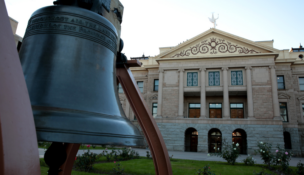Lawmakers pessimistic as budget panel meets
Arizona Capitol Reports Staff//January 11, 2008//[read_meter]
Lawmakers pessimistic as budget panel meets
Arizona Capitol Reports Staff//January 11, 2008//[read_meter]
Members of both parties are questioning whether joint appropriations committee meetings will solve what may be a nearly $1 billion budget deficit.
More than two-dozen senators and representatives gathered nearly a week before the legislative session was slated to begin to examine the current state budget and review possible options.
A budget fix won’t be passed by lawmakers and approved by Gov. Janet Napolitano until the House speaker and Senate president negotiate an agreement with her, said Rep. Pete Rios, D-23.
“At the end of the day, what happens (in the committee) doesn’t matter,” he said. “The other 88 legislators are pawns that are going to be positioned as needed.”
When the joint appropriations committee hearing schedule kicked off Jan. 8 — the House and Senate members also met the following two days — chairmen Sen. Bob Burns, R-9, and Rep. Russell Pearce, R-18, said they hoped the committee would do the lion’s share of the work.
“I would hope that this (committee) could do 95 percent of the work here, that there’s very little left (for negotiators) to do,” Pearce said.
But even Republicans on the committees acknowledge the likelihood that the budget changes approved by the committee won’t garner Napolitano’s support, given that the committees are overwhelmingly Republican. That means the deficit solutions will probably include more budget cuts and less borrowing than what the governor has proposed, said Sen. Jim Waring, R-7.
“I think (Pearce’s goal) is going to be very difficult,” he said. “What happens, in my experience…is we can come out with a budget that does 95 percent of what the chairmen want.
“We might be able to do a budget that does 95 percent of the work to get a budget up to her, but she has to sign it… I’m skeptical we’ll produce something from this committee that she will sign.”
Even Pearce, in an interview a day before the committees began to meet, conceded as much.
“Bob (Burns) and I will put the options on the table…but we understand there’s going to be some considerable wrangling over them in negotiations,” he said Jan. 7.
There still is a purpose to the hearings, Pearce said, even if the committee’s recommendations closely resemble the spending-cut-heavy proposal Pearce and Burns released Jan. 4 and will be used merely as a starting point for negotiations.
“Bob and I work on the budget pretty much year-round, but the members don’t, so I’m hoping it will give the members a better comfort,” he said.
And Rios, who believes the bulk of the heavy lifting on addressing the deficit will be done “behind closed doors,” agrees that it is still important for the committee members to have the opportunity to speak with state agency directors.
“It’s not totally fruitless…because members are getting an education as to what the reductions are going to be and their impacts,” he said.
Solutions
On Jan. 8, Burns and Pearce released their proposed solution to address the deficit, which has been estimated at $970 million by the Joint Legislative Budget Committee. The plan would make large, permanent cuts in funding for most state agencies.
Among the items are:
• A 10-percent cut in funding for state universities, totaling about $110 million, and suspending the money normally provided to community colleges for capital projects.
• Reducing the funding for community health centers by $4.5 million.
• A delay of $42 million for new school construction.
• Trimming eligibility for a program that provides health insurance to the children of the working poor, cutting costs by about $1.2 million.
Pearce said permanent cuts are needed because the economy is not likely to recover in the immediate future. Rather, it will be several years before growth returns to normal, and the state can’t continue to spend more than it collects in the meantime, he says.
House Minority Leader Phil Lopes, D-27, called the proposal “draconian” and said the state shouldn’t dramatically cut services for the poor and elderly at the time those populations are most likely to need help.
He also said the Republican plan is an overreaction to a situation that is bad, but will surely get better soon. The state’s economy, Lopes said, is cyclical by nature.
“There’s no economic conditions I’m aware of to make me believe that cycle won’t continue,” he said. “We’ve got to continue services, we’ve got to continue (building) schools, we’ve got to continue to build roads, because we’re a growing state.”
The plan by Burns and Pearce would not make up the entire $970-million deficit with spending cuts. It also relies on a $350-million withdrawal from the state’s Rainy Day fund and about $30 million in education savings resulting from lower-than-expected enrollment in state schools.
Earlier this month, Napolitano proposed a combination of spending cuts, borrowing and the Rainy Day fund money to address a shortfall her economists estimate at $870 million. Her plan includes $214 million in state agency spending reductions, $393 million in borrowing for new school construction and $263 million from the Rainy Day fund.
















